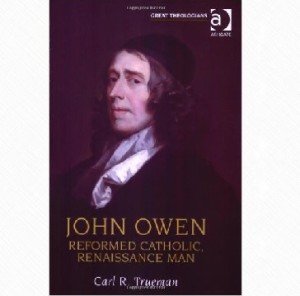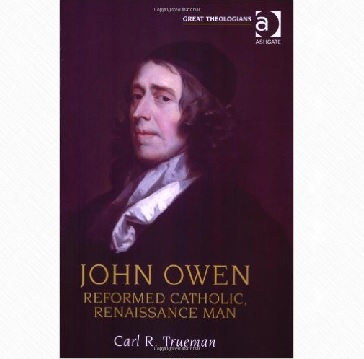 A review of Carl Trueman’s John Owen: Reformed Catholic, Renaissance Man, Aldershot: Ashgate Publishing, 2007, 132 pages, including index.
A review of Carl Trueman’s John Owen: Reformed Catholic, Renaissance Man, Aldershot: Ashgate Publishing, 2007, 132 pages, including index.
Dr. Carl R. Trueman, Professor of Church History at Westminster Theological Seminary, Philadelphia, and the author of an earlier title on Owen, The Claims of Truth: John Owen’s Trinitarian Theology, 1998, continues his work with the sometimes obtuse though weighty theologian. Dr. Trueman’s brief book is intended to help students with the ponderous and wordy complexity of Owen. The book contains one hundred twenty eight pages of text that are subdivided into four chapters of roughly thirty pages each. The first chapter, containing six sections, begins with a short introduction to Owen’s life and thought, establishes definitions, and provides a conclusion concerning these areas. Chapter two has ten divisions and presents Owen’s thoughts on, “The Knowledge of the Trinitarian God,” including the attributes of God, the Deity of Christ and the Holy Spirit, as well as other issues harvested from Owen’s voluminous writings. “Divine Covenants and Catholic Christology,” constitutes the subject matter of the twelve sections of the third chapter, which include discussion of the Covenants of Works, Grace, and Redemption, along with thoughts on the priesthood of Christ. Justification, a perpetually argued and foundational doctrine of theology, is the subject of chapter four, which addresses this hinge-pin of religion with sections on faith and works, eternal justification, and the imputation of the active and passive righteousness of Christ. The brief length of the book necessitates some chapter subdivisions being as short as a page, while others are as long as five or six. The book provides a survey of Owen’s thought with the intention of giving its readers an overview. All of this is wrapped, at least in the paperback version, in an attractive and tactilely pleasing black satin finished cover into which is fused a reproduction of John Greenhill’s portrait of Owen at the National Gallery, London. Greenhill’s brushwork presents Owen with a self-assured, confident, maybe even cocky appearance as he looks across his narrow, Isoscelesian triangular nose at his interested but apprehensive audience.
Chapter one ventures into the arena of conflict over the meaning of “Puritan.” The debates over the definition of this word seem endless; Trueman adds to the foray by providing another descriptive designation, “Reformed Orthodox,” which is a category he borrowed from Richard Mueller, but it seems that Dr. Trueman is not quite content with this designation because by the time he reaches the end of the book he returns to this troublesome word “Puritan” to refine his definition. Though “Reformed Orthodox” designates Owen’s thought within the Renaissance-Reformation context and the general flow of Reformed theology, Trueman comments that, “Owen was, of course, a Puritan theologian” (p. 127). The author’s use of both Reformed Orthodox and Puritan shows the complex nature of seventeenth-century England, a complexity created by theological, ecclesiastical and political conflicts.
One reason that “Puritan” is often seen as an ambiguous term is that many of the interpreters of the era have failed to take the theology of Puritanism seriously; for some students of the period “Puritan” designates a philosophical, sociological, political, and/or psychological perspective that is a negative cultural influence with little if any positive value. Many analysts trivialize, suppress or ignore the fact that the “Puritans” were driven by their theological commitments drawn from biblical study and faith in the gospel of Jesus Christ. Puritans sought a pure church and their zealous pursuit sometimes involved political and social excesses, but the impetus behind their actions was the belief that pure worship of God could only be achieved through liturgy and doctrine drawn from the deep well of Scripture. Church history is marked repeatedly by problems with the confusion of church and state and Owen, like most Englishmen, had political ideas and lived within a particular political milieu, after all, he was Oliver Cromwell’s chaplain for a time, but the Puritans believed and hoped that their politics and social perspective were as biblical as their theology. Trueman’s setting of Owen’s thought in the Reformed Orthodox set allows him to properly apply “Puritan” to Owen in the sub-set of those who reformed and purified the Church of England.
The author dedicates about two pages of his text to presenting Owen’s views on the Divine simplicity, a subject not often, if ever, discussed over tea and cucumber sandwiches (38-39). The source for Trueman’s analysis is the section of his Works titled, “Mr. Biddle’s Preface Briefly Examined,” which follows Owen’s transcription of Biddle’s Preface at the beginning of Vindiciae Evangelicae; or the Mystery of the Gospel Vindicated and Socinianism Examined (Owen’s Works, vol. 12). John Biddle (1615-1662), Oxford educated, was in and out of prison and finally met his death while incarcerated for questioning the divinity of the Holy Spirit, upholding Unitarianism, and propounding Socinianism. Biddle’s preface occupies only a few pages, but John Owen’s dismantling of it goes on for several leaves, despite being described as “Briefly Examined.” Owen’s conclusions are summarized by Trueman with four points: first, “God has ontological priority over everything else and enjoys total independence”; second, “God is absolutely and perfectly one and the same; his essence is what it is, and contains nothing that is accidental to it or which differs from it; third, “all his attributes enjoy perfect oneness and unity in God, since all attributes are infinitely perfect and thus essentially identical with the being of God”; and fourth, “God contains no potency to be other than that which he is; he is perfect and self-existent and can never be any different” (38-39). Needless to say, the weight and complexity of these four points display a mind consumed with contemplation of what biblical revelation has to say about God. Trueman concludes that Owen’s analysis of the simplicity of God includes the thought of Suarez, the Spanish Jesuit thinker, as well as Cajetan’s commentary on Aquinas’s work, thus the “Reformed Catholic,” in Trueman’s title of his book, indicates Owen’s continuity with the medieval and Renaissance theological past, while breaking with Rome in his Reformed Orthodoxy. Owen’s analysis shows that Socinian teaching is dependent upon a denial of Divine simplicity in that the Socinian heresy provides a “reconstruction of the doctrine of God… [and]…radically limits” God’s being and power. Thus, Owen critiqued Biddle using the thought of past exegetical scholarship, while infusing his own spade-work and contemplation; Owen’s work as a Puritan exegete continued in the spirit of the Reformation’s sola Scriptura as he critically searched the biblical commentaries and analyses of the theologians who had gone before.
One of the most relevant subjects addressed by Owen, in light of controversies within the present-day Reformed churches, is his teaching on the doctrine of justification. A point of discussion at the Westminster Assembly regarding this doctrine involved the views of William Twisse and Thomas Gataker, both of whom contended that it was Christ’s passive righteousness that is imputed to the believer and not his active righteousness—that is, what Christ suffered according to the will of the Father as the Lamb of God, his sacrificial obedience to the Father, not what Christ accomplished by his perfect obedience to the Law. Though this may seem a minor point, it is important for Reformed theology because Arminius held a similar view to that of Twisse and Gataker and some divines saw this as theologically problematic. Justification was argued early in the assembly as the divines were still about the work of revising the Thirty Nine Articles. Debate on Article 11, “Of the Justification of Man before God,” included extended analysis by Daniel Featley as he contended for the two-fold righteousness of Christ being imputed to the Christian, the result of which was the adoption of the terminology, “whole obedience and satisfaction” in the revised article, which was then incorporated in the Westminster Confession without “whole” and reading “obedience and satisfaction” in 11:1, 3. Thus, though the specific terms “active” and “passive” were not adopted by Westminster, the sense of the imputed righteousness is twofold. The Westminster Assembly steered well clear of the view of Twisse and Gataker and affirmed the twofold obedience, but John Owen believed the terminology was not specific enough to convey the fullness of the Lord’s obedience and the righteousness imputed. Trueman observes that Owen influenced the Savoy Declaration, 1658, “which was essentially a modification of the Westminster Confession,” and makes “specific reference to the imputation of both the active and passive righteousness of Christ” (107). Owen believed the use of both active and passive was necessary to maintain the integrity of Christ’s person and avoid overemphasis of his natures. That is, Owen saw the active and passive aspects as so unified in the person of the Messiah that they were inseparable—the less specific terminology of Westminster was more susceptible to emphasis of the divine and human natures at the expense of the person of Christ (109). Owen’s influence is clearly present in the Savoy Declaration, 11:1, which shows that the statement, “Christ’s active obedience unto the whole Law, and passive obedience in his death for their whole and soul righteousness,” has been inserted in place of “the obedience and satisfaction of Christ unto them” in the Westminster Confession. All of Christ’s righteousness is laid to the account of the elect according to the Westminster Assembly; all of Christ’s righteousness, as active and passive, is imputed to the Christian according to Savoy. Either statement teaches that the entirety of the obedient Lord’s work is imputed to the elect through justification, but Owen’s influence at Savoy resulted in more specific terminology that refined the wording of Westminster but both confessions teach the two-fold imputation of Christ’s righteousness in justification.
Carl Trueman’s brief analysis of the massive body of writings constituting John Owen’s work provides an overview of many areas of his theological writing. This reviewer’s brief interaction with Trueman’s analysis of Owen on the simplicity of God and the more extended comments on Owen and justification show the complexity of the Cromwell’s chaplain’s thought. Any of the subjects Dr. Trueman presents regarding Owen’s writings might just as well yield extended analysis, contemplation and interaction—Owen is complex, profound, and sometimes may tend towards speculating on the number of angels dancing on the head of a pin, but the dedicated student will be rewarded by plodding through the rugged terrain of Owen’s thought. Trueman’s brevity is both the strength and weakness of the book—summarizing gives one an overview, but overviews always leave gaps that the reader might like to have filled, but the gaps should encourage readers to dig into subjects of their own interest. Dr. Trueman shows a thorough acquaintance with the secondary literature of his own generation and an extensive knowledge of the primary sources of Owen’s era as well. He has amply shown that those who want to enter the mind of John Owen must be prepared to exercise their brain-matter in ways that will stretch their analytical abilities and help them to “plumb the depths of the riches of the wisdom and knowledge of God” as explained in the works of Owen.
Thanks to Carl Trueman’s handy summary, the labyrinth of Owen’s thought has been straightened and made more maneuverable for students venturing into the intricacies of his theological universe.
BARRY WAUGH





